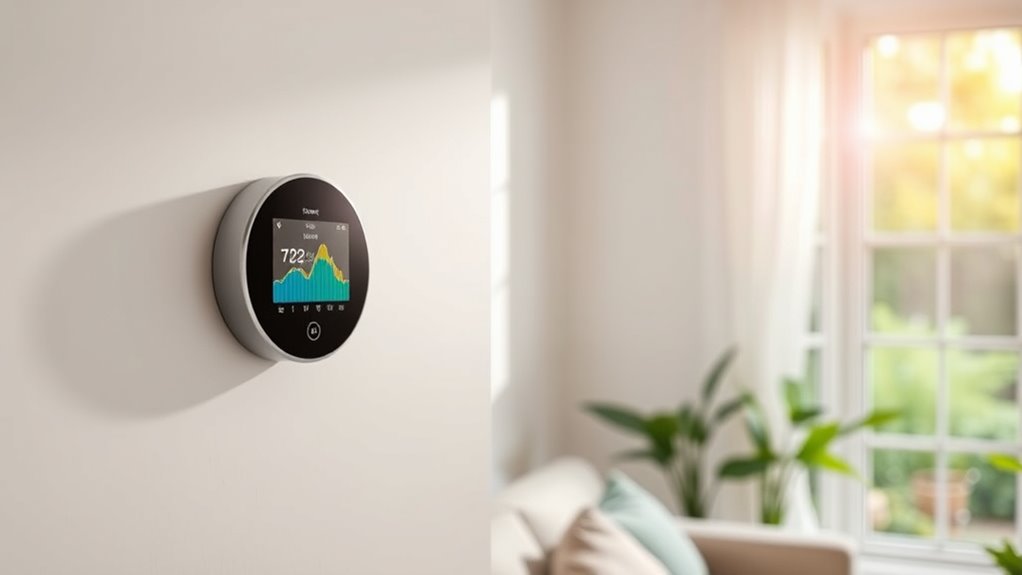By analyzing your smart thermostat’s data, you can determine the best times to heat and cool your home for maximum comfort and efficiency. It learns your routines, like when you’re waking up, leaving, or returning, and adjusts settings accordingly. Pre-heating before you wake or arrive home helps save energy while keeping your space comfortable. Keep going to discover how to fine-tune your schedule even further for ideal results.
Key Takeaways
- Analyze occupancy patterns to identify when the home is unoccupied, optimizing heating and cooling schedules accordingly.
- Pre-condition the home before expected arrival times to ensure comfort while avoiding unnecessary energy use.
- Use real-time temperature and occupancy data to dynamically adjust settings, responding to changes in weather and routines.
- Schedule heating or cooling to start shortly before active periods, balancing comfort with energy efficiency.
- Leverage sensor data to detect prolonged inactivity or low occupancy, reducing energy waste during these times.

Have you ever wondered how smart thermostats collect and utilize your home temperature data? These devices don’t just set a temperature and leave it there; they analyze patterns to optimize your comfort and save energy. By learning your daily routines, smart thermostats can determine the best times to heat or cool your home, ensuring you’re comfortable when you’re there and saving energy when you’re away or asleep. This intelligent use of data helps you lower your utility bills without sacrificing comfort, making your home more efficient overall.
Smart thermostats continuously monitor your home’s temperature and occupancy patterns. They gather data from sensors and your manual adjustments to understand when you typically wake up, leave for work, return, or go to bed. With this information, the thermostat can automatically adjust its schedule, pre-heating or pre-cooling your space just before you arrive, so your home feels perfect when you need it. This proactive approach ensures you don’t waste energy maintaining temperatures when no one’s home or when everyone’s asleep, ultimately leading to significant energy savings over time. Additionally, real-time data analysis enhances their ability to adapt to changing routines and weather conditions.
Smart thermostats learn your schedule to optimize comfort and energy efficiency automatically.
The key to making the most of this data is understanding the ideal times to heat and cool your house. During the day, you might find that lowering the temperature slightly in winter or raising it in summer when you’re away results in less energy consumption while maintaining comfort during your active hours. In the mornings and evenings, setting the thermostat to a comfortable level ensures you wake up or come home to a cozy environment. Many smart thermostats learn from your habits, adjusting their schedules automatically, but you can also manually fine-tune settings based on your preferences or seasonal changes. Incorporating behavioral patterns can further optimize your system’s efficiency.
Utilizing a smart thermostat’s data means you’re not just reacting to your home’s temperature but actively managing it for maximum efficiency. For example, setting your system to start heating or cooling shortly before you wake up or return home prevents energy waste while still providing user comfort. The data-driven insights help you identify patterns you might not notice, like times when your house stays warm longer than necessary or cools down too quickly at night. Armed with this knowledge, you can refine your settings to optimize energy savings while keeping your living space comfortable.
In essence, the best times to heat and cool are dictated by your lifestyle and the smart thermostat’s ability to learn from your data. By trusting this technology, you can enjoy a more comfortable home and lower energy bills, all without constant manual adjustments. Your smart thermostat acts as a personalized energy manager, leveraging historical and real-time data to make your home more efficient and comfortable around the clock. Additionally, high-quality sensors play a crucial role in gathering accurate data to support these adjustments effectively.
Frequently Asked Questions
How Accurate Is Smart Thermostat Data Compared to Traditional Methods?
Smart thermostat data is quite accurate, especially when sensor accuracy is high. You can rely on it for consistent temperature control because modern sensors detect changes precisely. Data reliability improves with proper placement and calibration, reducing your need for manual adjustments. Overall, smart thermostats provide dependable information, often surpassing traditional methods by offering real-time insights and automation, ensuring your home stays comfortable efficiently.
Can Smart Thermostats Predict Future Weather Impacts on Energy Use?
Smart thermostats can indeed predict future weather impacts on energy use through weather forecasting data integration. By analyzing local weather patterns and historical data, they adjust your heating and cooling proactively. This energy prediction helps optimize comfort and efficiency, saving you money. You’ll benefit from smarter climate control that anticipates changes, rather than just reacting to current conditions, making your home more responsive to upcoming weather shifts.
How Does Occupancy Detection Influence Optimal Heating and Cooling Times?
Occupancy sensing plays a key role in optimizing your heating and cooling times by detecting when spaces are occupied or vacant. This data helps you implement zoning strategies, which direct climate control only where needed, saving energy. As a result, your smart thermostat adjusts temperature settings dynamically, ensuring comfort while minimizing waste. By leveraging occupancy detection, you create more efficient heating and cooling patterns tailored to your daily routines.
Are There Privacy Concerns With Smart Thermostat Data Collection?
You might think privacy concerns are exaggerated, but smart thermostats do collect your data, raising real worries about data security. While they help optimize heating and cooling, your personal habits and routines are stored, making you vulnerable to breaches. It’s ironic—your smart device’s convenience could compromise your privacy. Stay aware and guarantee your thermostat provider prioritizes data security, so your comfort doesn’t come at the expense of your privacy.
Can Data Analytics Help Reduce Overall Energy Costs Effectively?
Data analytics can substantially help reduce your overall energy costs by optimizing your heating and cooling patterns. When you analyze your energy consumption, you identify inefficient usage and adjust settings accordingly. This results in cost savings and more sustainable energy use. By leveraging smart thermostat data, you can fine-tune your system to operate only when needed, making your home more energy-efficient and lowering utility bills effectively.
Conclusion
By harnessing your smart thermostat’s data, you’re fundamentally giving your home a heartbeat, syncing comfort with efficiency. Think of it as conducting an orchestra where every temperature change hits the right note at just the right time. When you fine-tune these settings, your energy bills become a gentle stream rather than a raging river. Embrace this digital maestro, and watch your home transform into a cozy haven that breathes in harmony with your life.









